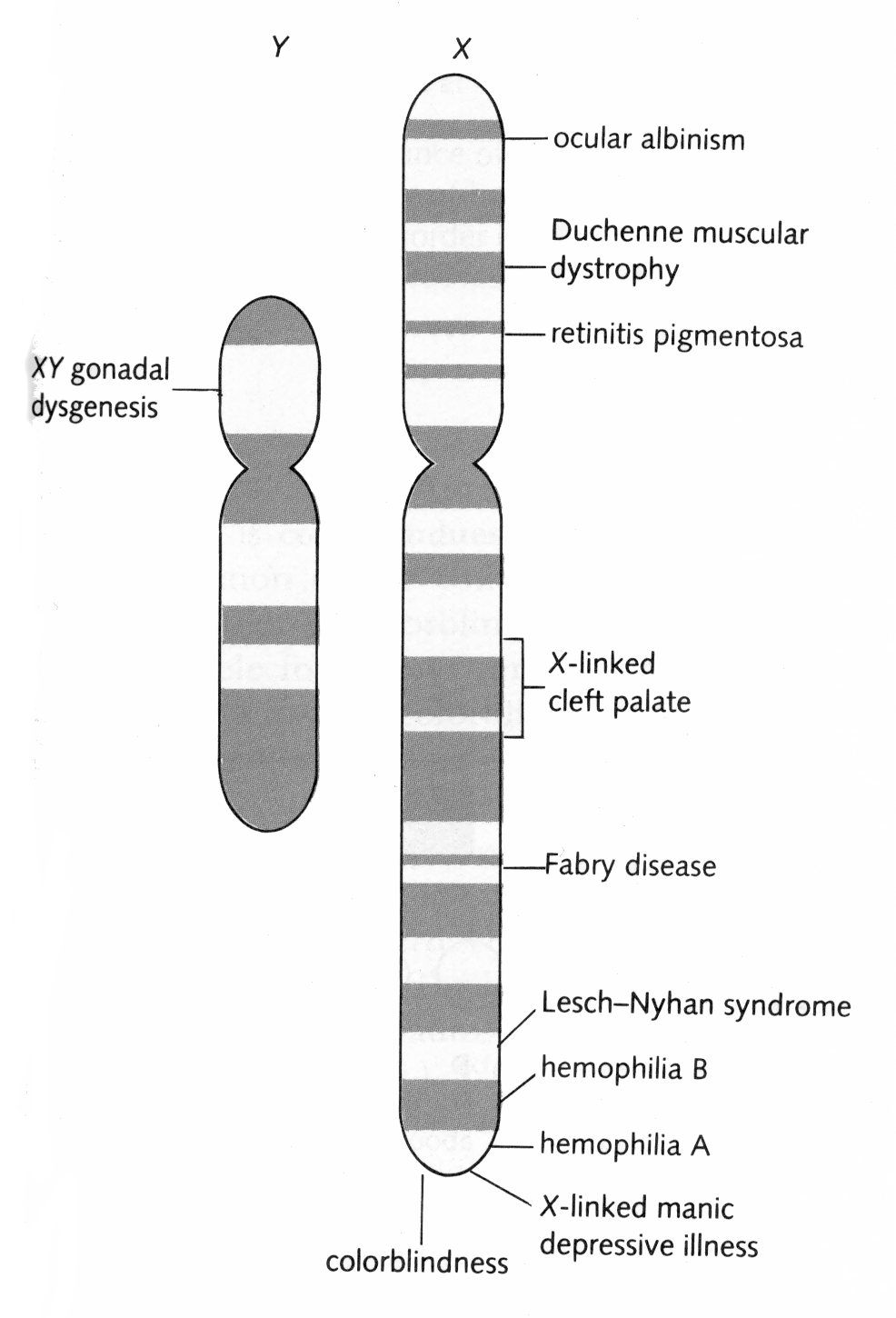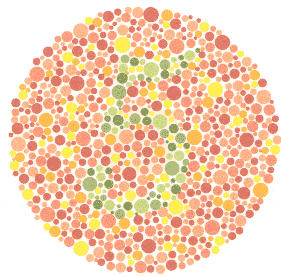1. Introduction to Sex-linked Genes: A Slideshow
Start by viewing these slides. Note that if you can’t view the slideshow below, don’t worry: it’s all covered below. It’s something in your District’s network settings that’s blocking your view (and as much as I’d like to share this with you, I can’t). Sorry!
2. Reading about Hemophilia: A Sex Linked Trait
In humans, most other mammals, and some insects (notably, the well-studied fruit fly), sex is determined by sex chromosomes. These chromosomes are also known as the X and Y chromosomes, and the way they determine sex is as follows:
- If you possess an X chromosome and a Y chromosome, you’re male.
- If you possess two X chromosomes, you’re female.


As you can see in the photograph on the left, the X-chromosome is a lot bigger than the Y-chromosome. As a result, as you can see in the partial chromosome map on the right, the genes on the X chromosome have no corresponding gene on the Y chromosome.
This makes the inheritance of genes on the X chromosome different from genes that are on autosomal (non-sex) chromosomes. And to see how, let’s look at a gene that’s close to the bottom of the X chromosome: the gene for hemophilia.

Hemophilia is a recessive inherited blood disorder. Hemophiliacs can’t form blood clots. While minor cuts aren’t usually a problem, hemophiliacs have significant problems with internal bleeding. How is this disease inherited?
If you’re a male hemophiliac, you’ve inherited the allele that causes the disease through your X chromosome. Remember that the allele is a sequence of DNA that codes for a protein. In this case, the allele codes for a protein that isn’t working.
Males only have one X chromosome. So, if they inherit an X chromosome with the hemophilia allele, they’ll be a hemophiliac.
Because the allele is on the X chromosome, we use a special symbol notation to indicate the presence of the allele: Xh. An X chromosome that possessed the allele for normal blood clotting would be written as XH. No corresponding allele (either dominant or recessive) is found on the Y chromosome.
Traits like hemophilia that are caused by alleles on the X chromosome are called sex-linked or X-linked traits.
Use that information to complete the following table of possible hemophilia genotypes.
[qwiz qrecord_id=”sciencemusicvideosMeister1961-Sex-Linked Alleles: Interactive Table (Genetics)”]
[h]Sex Linked Alleles: Interactive Table
[q]
| Description | Genotype |
| Normal male | ___ ___ |
| Hemophiliac male | ___ ___ |
| Homozygous Normal Female | ___ ___ |
| Heterozygous Normal female | ___ ___ |
| Hemophiliac Female | ___ ___ |
[l]XH
[fx] No, that’s not correct. Please try again.
[f*] Great!
[l]Xh
[fx] No, that’s not correct. Please try again.
[f*] Correct!
[l]Y
[fx] No, that’s not correct. Please try again.
[f*] Great!
[/qwiz]
3. A Pedigree for a Sex-Linked Trait
While males and females are equally likely to inherit the hemophilia allele, it’s much more likely for males to express the allele and have the hemophilia trait. You can see this in the pedigree chart below. Individual I-2 is none other than Queen Victoria, the first person in which hemophilia appears in the royal families of Europe. She passed the allele to II-1, her son Leopold, and to at least some of her daughters, who then passed it to Victoria’s grandchildren, three of whom were hemophiliacs. Generation IV includes six hemophiliacs.
See if you can identify the genotypes of some of the individuals below. Here’s the key
- SQUARES are males
- Circles are females.
- Squares that are filled in are hemophiliacs.
In this pedigree, carriers are not explicitly shown.
Adapted from an image by Zlir’a via Wikimedia Commons
[qwiz style=”width: 650px; min-height: 0px; border: 2px solid black;” qrecord_id=”sciencemusicvideosMeister1961-Sex-Linkage: Interactive Pedigree (Genetics)”]
[h]Sex-Linked Alleles: Interactive Pedigree
[q labels = “top”]
[l]XHY
[fx] No. Please try again.
[f*] Excellent!
[l]XhY
[fx] No. Please try again.
[f*] Good!
[l]XHXH
[fx] No, that’s not correct. Please try again.
[f*] Correct!
[l]XHXh
[fx] No, that’s not correct. Please try again.
[f*] Good!
[l]XhXh
[fx] No, that’s not correct. Please try again.
[f*] Excellent!
[/qwiz]
4. Solving a Genetics Problem Involving Sex Linkage

Hemophilia is only one of several human, sex-linked conditions. Others include Red-Green colorblindness and Duchenne’s muscular dystrophy.

Sex linkage also occurs in animals, most notably fruit flies, one of biology’s most studied organisms. In fruit flies, a recessive allele that causes white eyes is located on the X chromosome. The dominant allele codes for the normal phenotype, red eyes.
To solve genetics problems involving sex linkage, you use the same six steps that you’ve used in previous tutorials. Click here for a review.
[qwiz qrecord_id=”sciencemusicvideosMeister1961-Sex-Linkage: Interactive Punnett Square (Genetics)”]
[h]Sex Linkage: Interactive Punnett Square
[q]A woman who is a carrier for hemophilia (she has the allele but not the trait) has children with a normal (non-hemophiliac) man. What will be the genotypes and phenotypes of their offspring?
Genotypes of the parents
Mother: ___ ___
Father: ___ ___
| Father | |||
| ___ | ___ | ||
| Mother | ___ | ___ ___ | ___ ___ |
| ___ | ___ ___ | ___ ___ | |
Genotype ratio:
_____XHY: ____XhY: _____XHXH: ___XHXh:_____XhXh
Phenotype ratio:
_____ Hemophiliac man
_____ Normal blood-clotting man:
_____ Homozygous normal woman
_____ Carrier (heterozygous) woman
_____ Hemophiliac woman
[l]XH
[fx] No. Please try again.
[f*] Excellent!
[l]Y
[fx] No, that’s not correct. Please try again.
[f*] Good!
[l]Xh
[fx] No. Please try again.
[f*] Great!
[l]0%
[fx] No. Please try again.
[f*] Good!
[l]25%
[fx] No. Please try again.
[f*] Excellent!
[l]50%
[fx] No, that’s not correct. Please try again.
[f*] Correct!
[l]75%
[fx] No. Please try again.
[f*] Good!
[l]100%
[fx] No. Please try again.
[f*] Correct!
[x]
[restart]
[/qwiz]
What’s next
- Dihybrid Crosses (the next tutorial in this series)
- Genetics Main menu
